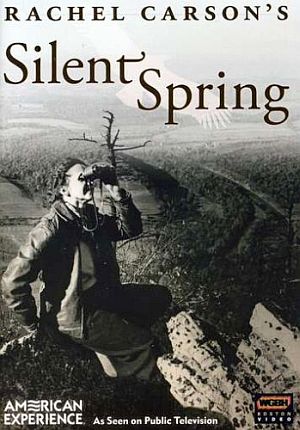
Rachel Carson’s
Silent Spring is a documentary film that was shown on US television (PBS) and
released on DVD in 2007. This film, which runs for 55 minutes, is an episode of
the long-running program American Experience.
Rachel Carson was
born in in 1907. When she died in 1964, she was only 56. Her life was cut short
by cancer. American Experience released this film in 2007 in order to mark the
100-year anniversary of her birth.
Ten years later American
Experience presented a brand new film about Rachel Carson. It was shown on US
television (PBS) and released on DVD in January 2017. The new film, which is called Rachel Carson, is twice as long as the old film from 2007, and it covers her life
and career in great detail. Here is some basic information about it:
*** Written and
directed by Michelle Ferrari
*** Produced by
Rafael de la Uz and Michelle Ferrari
*** The voice of
Rachel Carter is read by Mary-Louise Parker
*** Narrated by
Oliver Platt
*** Run time: 113
minutes
Several persons are interviewed in the new film.
Here are the names in the order of
appearance:
The first group
** William Souder,
biographer
** Deborah Blum,
writer
** David Kinkela,
historian
** Mark H. Lytle,
historian
** Naomi Oreskes,
historian
The second group
** Linda Lear,
biographer
** Robert K.
Musil, environmental scientist
** Deborah Cramer,
writer
** Martha Freeman,
Dorothy Freeman’s grand-daughter
** Roger Christie,
Rachel’s grand-nephew and adopted son
Rachel Carson was
a biologist and a writer. For several years she worked as a marine biologist
for a US Government agency. In her free time she wrote books and articles about
nature, focusing on the sea. Her books were quite popular. Eventually, they
were so popular that she was able to quit her job and become a full-time
writer.
Her most important
book was her last book: Silent Spring, which was published in 1962, shortly
before her death. The book has a strong message, a strong warning. She wants to
warn the world against excessive use of DDT and other pesticides:
When we want to
kill certain insects, such as mosquitoes carrying malaria, we are at the same
time polluting the environment and ultimately putting our own survival at risk.
Back in 1962, such
a message was revolutionary. At the time there was no sense that we must protect
the environment. There was no understanding that pollution is a serious problem
that deserves our attention.
Her book became a
bestseller in the US. When it was translated into other languages, it became an
international bestseller. Today, her book is seen as the catalyst which started
the environmental movement in the US and indeed in the whole world.
When she made her
statement, not everybody agreed with her, not everybody was happy about it. Why?
Because she was accusing big business of disregarding the environment, of
putting profits before people. The managers of big business were not happy to
see such a message. She also accused the government of neglecting the problem.
She urged the US government to regulate this issue, so nature could be
protected.
The general
public, on the other hand, received her message with enthusiasm. Environmental
movements were formed all over the US and in many other countries around the
world. These movements put so much pressure on their governments that they had
to issue laws to protect the environment.
While these laws
are not always tough enough, while these laws are not always respected, the
current situation is still very different from the situation that existed
before Rachel Carson published her book in 1962.
She is regarded as
the person who inspired the environmental movement that grew up in the 1970s,
which is a remarkable fact, given that she herself was a very private person.
As stated above, this
film covers her life and her career in great detail. The witnesses are
well-chosen. Between the “talking heads” there is a lot of old footage, photos
as well as film. Obviously, most of this old footage is in black-and-white. The
old footage is also well-chosen.
The story of
Rachel Carson is important. It deserves to be told, and this film does it very
well. If you are interested in the history of the modern world – in particular
the development of environmental concerns – this film is definitely
something for you.
PS # 1. I do not
wish to say anything bad about the old film from 2007. But if you have a choice
between the old film from 2007 (55 minutes) and the new film from 2017 (113
minutes), I am quite sure you will prefer the latter over the former.
PS # 2. Writings
by Rachel Carter:
** Under the Sea
Wind (1941)
** The Sea Around
Us (1951, 1991)
** The Edge of the
Sea (1955, 1998)
** Silent Spring
(1962, 2002)
PS # 3. For more
information, see the following books:
** On a Farther
Shore: The Life and Legacy of Rachel Carson, Author of Silent Spring by William
Souder (2012, 2013)
** DDT and the
American Century by David Kinkela (2011, 2013)
** Rachel Carson:
Witness for Nature by Linda Lear (1998, 2009)
** The Gentle
Subversive: Rachel Carson, Silent Spring, and the Rise of the Environmental
Movement by Mark H. Lytle (2007)
*****

Rachel Carson on American Experience
(season 29 episode 4, broadcast in January 2017)
Here is a link to the American Experience website:
Rachel Carson
(season 29 episode 4, broadcast in January 2017)
Here is a link to the American Experience website:
Rachel Carson
*****
No comments:
Post a Comment